Optimized Dispatch of Integrated Energy Systems in Parks Considering P2G-CCS-CHP Synergy Under Renewable Energy Uncertainty
Abstract
1. Introduction
2. Methods and Analysis
2.1. Integrated Energy System Framework of the Park with Reward-and-Penalty Tiered Carbon Trading Mechanism
2.1.1. Modeling and Characteristics of P2G-CCS-CHP
2.1.2. Reward and Penalty-Based Tiered Carbon Trading Mechanism
- (1)
- Allocation Mechanism for PIES Carbon Emission Quotas
- (2)
- Initial Allocation Model for PIES Carbon Emission Rights
- (3)
- Actual Carbon Emission Model for PIES
- (4)
- PIES Reward-Punishment Tiered Carbon Trading Cost Model
2.2. Generation of Scenarios Considering Uncertainty and Correlation of Wind and Solar Outputs
2.2.1. Kernel Density Estimation Method
2.2.2. Copula Functions
2.2.3. Generation of Wind and Solar Scenarios and Their Complementary Characteristics
- (1)
- Static Scenario Generation and Reduction of Wind and Solar Power Outputs Based on Monte Carlo Simulation
- (2)
- Indicators of Wind-Solar Complementarity
2.3. Incentive-Based Ladder Carbon Trading with Consideration of Wind and Solar Uncertainty and the Coupling of P2G-CCS-CHP in Integrated Energy System Optimization Model
2.3.1. Objective Function
- (1)
- Economic Objectives
- (2)
- Environmental Objectives
2.3.2. Constraints
- (1)
- Power Balance Constraint
- (2)
- Equipment Capacity and Ramping Constraints
- (3)
- Energy Coupling Constraints
2.4. Model Solution Methods
2.4.1. Non-Dominated Sorting-Based Cockroach Optimization Algorithm
- (1)
- Non-Dominated Sorting Genetic Strategy
- (2)
- Dung Beetle Optimization Algorithm
- (3)
- Non-Dominated Sorting Dung Beetle Optimizer Model
2.4.2. Model Performance Test
3. Results and Discussion
3.1. Basic Data
3.2. Generation and Reduction of Scenarios Considering Wind and Solar Uncertainty and Correlation
3.3. Analysis of Optimization Scheduling Results
3.3.1. Analysis of the Impact of Wind and Solar Output Uncertainty, Reward-Punishment Tiered Carbon Trading Mechanism, and Coupling Operation of P2G-CCS-CHP
3.3.2. Analysis of PIES Optimal Scheduling in Scenario 6 (This Study’s Model)
3.3.3. Analysis of the Impact of Reward and Penalty Coefficients on PIES Dispatching
- (1)
- In scenarios where carbon trading costs are negative, increasing the reward coefficient significantly amplifies the benefits that PIES gains from carbon trading. As carbon trading prices rise, these benefits progressively increase. This effect occurs because higher carbon trading revenues encourage PIES to minimize its dependence on external energy sources while boosting the efficiency of various energy supply and conversion devices within the system, ultimately leading to a significant reduction in overall carbon emissions.
- (2)
- In contrast, when carbon trading costs are positive, an increased penalty coefficient results in higher fines for PIES. To mitigate these penalties, PIES should strategically implement voluntary decarbonization scheduling. By integrating multi-energy coupling—encompassing electricity; heat; gas; and cooling—and employing energy conversion technologies such as Power-to-Gas (P2G); Carbon Capture and Storage (CCS); and Combined Heat and Power (CHP); these scheduling efforts can create situations where a higher penalty coefficient corresponds with lower carbon trading costs.
- (3)
- During PIES’s operational scheduling, it is critical to manage the interplay between reward and penalty coefficients and carbon trading costs to identify the optimal balance point. Achieving this balance is essential for reducing carbon emissions while ensuring the economic viability of scheduling practices. This could involve establishing distinct thresholds for reward and penalty adjustments based on real-time trading data and market trends.
- (4)
- Fluctuations in carbon trading prices will directly impact the associated revenues or costs for PIES. Therefore, it is vital to establish a dynamic strategy to adjust operational scheduling in response to these price changes, maximizing revenues or minimizing costs effectively in real-time.
- (5)
- PIES must enhance its monitoring and analysis of the carbon trading market to stay informed about market trends and price movements. Continuous monitoring will provide valuable data to inform scheduling decisions, enhancing responsiveness to market changes. Key focus areas include tracking emerging regulations, competitor behaviors, and shifts in overall market demand, allowing for better-informed adjustments to operational strategies.
4. Conclusions Implications and Future Research Orientations
- (1)
- The proposed reward-punishment tiered carbon trading mechanism achieves substantial decarbonization performance, reducing PIES carbon emissions by 31.30% (6191.99 kg) compared to conventional mechanisms. This regulatory innovation establishes critical financial incentives that align market dynamics with environmental objectives, providing a policy-relevant framework for low-carbon transition management.
- (2)
- Through probabilistic modeling of renewable energy uncertainties and inter-source correlations, our framework enhances system sustainability across three dimensions: economic efficiency (+3.67% cost reduction/$880.42 savings), environmental performance (15.83% emission reduction/2150.78 kg mitigation), and renewable utilization (4.4% wind and 4.91% solar consumption increases). This tripartite optimization addresses the energy trilemma challenges in integrated energy systems.
- (3)
- The novel P2G-CCS-CHP coupling model demonstrates paradigm-shifting improvements over conventional systems. Relative to traditional CHP configurations, it achieves 28.86% wind and 19.85% solar utilization enhancements alongside a remarkable 36.91% cost reduction and 77.65% emission abatement. When benchmarked against existing P2G-CCS integrations, the proposed architecture further improves renewable consumption (21.68% wind, 15.02% solar) while reducing costs and emissions by 20.51% and 62.68%, respectively. These comparative results validate the technical superiority of our multi-system coupling approach.
- (4)
- The biomimetic non-dominated sorting dung beetle optimizer introduces strategic multi-objective optimization capabilities, demonstrating 18–32% computational efficiency gains over PSO, MCA, POA, SABO, and HHO algorithms in Pareto front identification. This bio-inspired metaheuristic effectively resolves the convergence-precision trade-off in complex energy system optimizations.
Author Contributions
Funding
Data Availability Statement
Conflicts of Interest
Abbreviations
| PIES | Park integrated energy system | MT | Micro-gas Turbine | ER | Electric refrigerator |
| P2G | Power to gas | NSGS | Non-dominated Sorting Genetic Strategy | PV | Photovoltaic power generation |
| CCS | Carbon capture and storage | DBO | Dung beetle optimizer | BR | Backward reduction |
| CHP | Combined heat and power generation | NS | Natural gas sources | CV | Coefficient of variation |
| NSDBO | Optimization algorithm of dung beetle under non-dominated sorting | WT | Wind turbine | MOP | Multi-object Optimization Problem |
| PSO | Particle Swarm Optimization | MCA | Musical Chairs Algorithm | POA | Pelican Optimization Algorithm |
| SABO | Subtraction-Average-Based Optimizer | HHO | Harris Hawk Optimization |
Appendix A
| Benchmarking Functions | Search Space |
|---|---|
| [−10, 10] | |
| [−5.12, 5.12] | |
| [−50, 50] | |
| [−65, 65] |
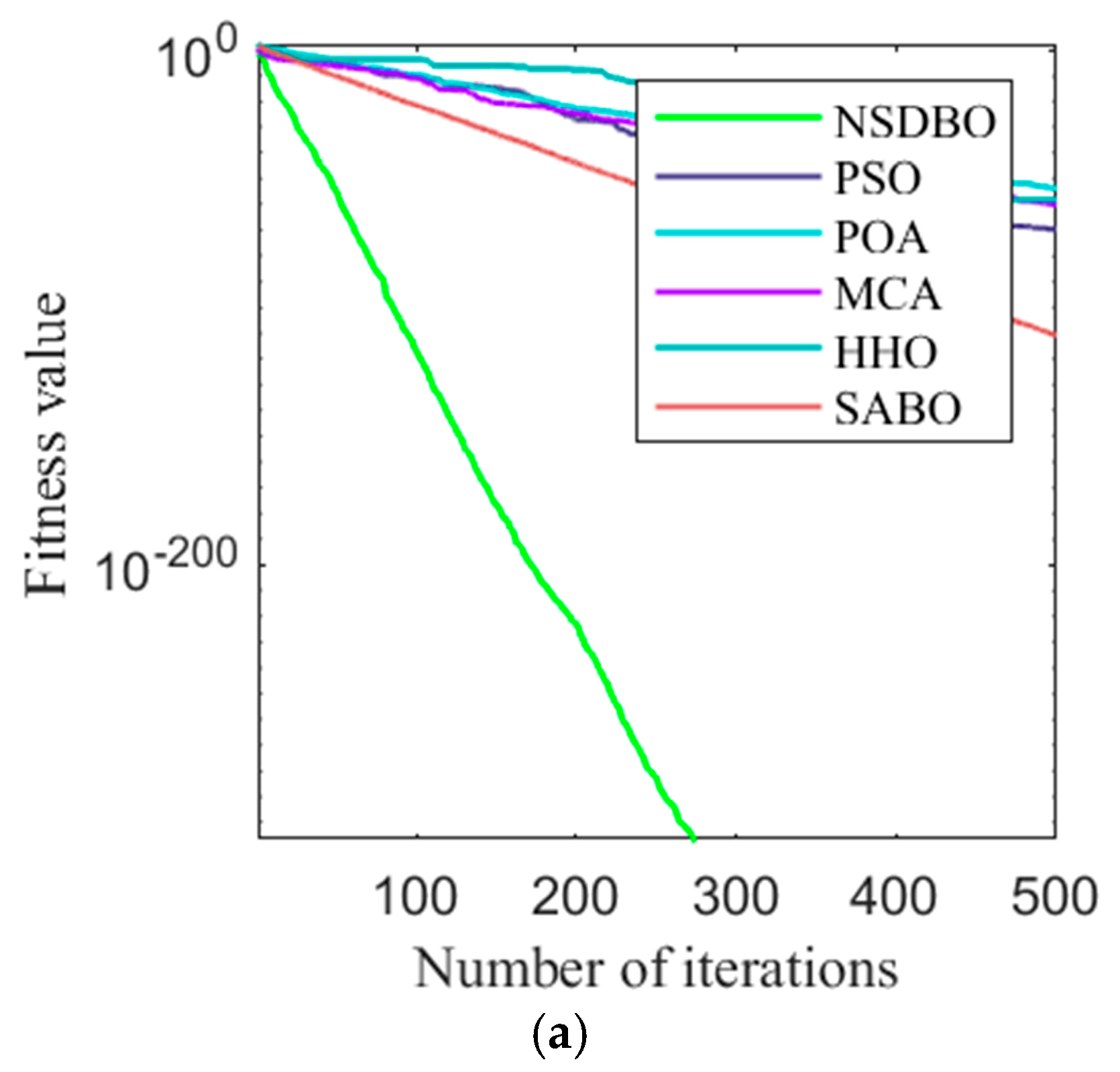
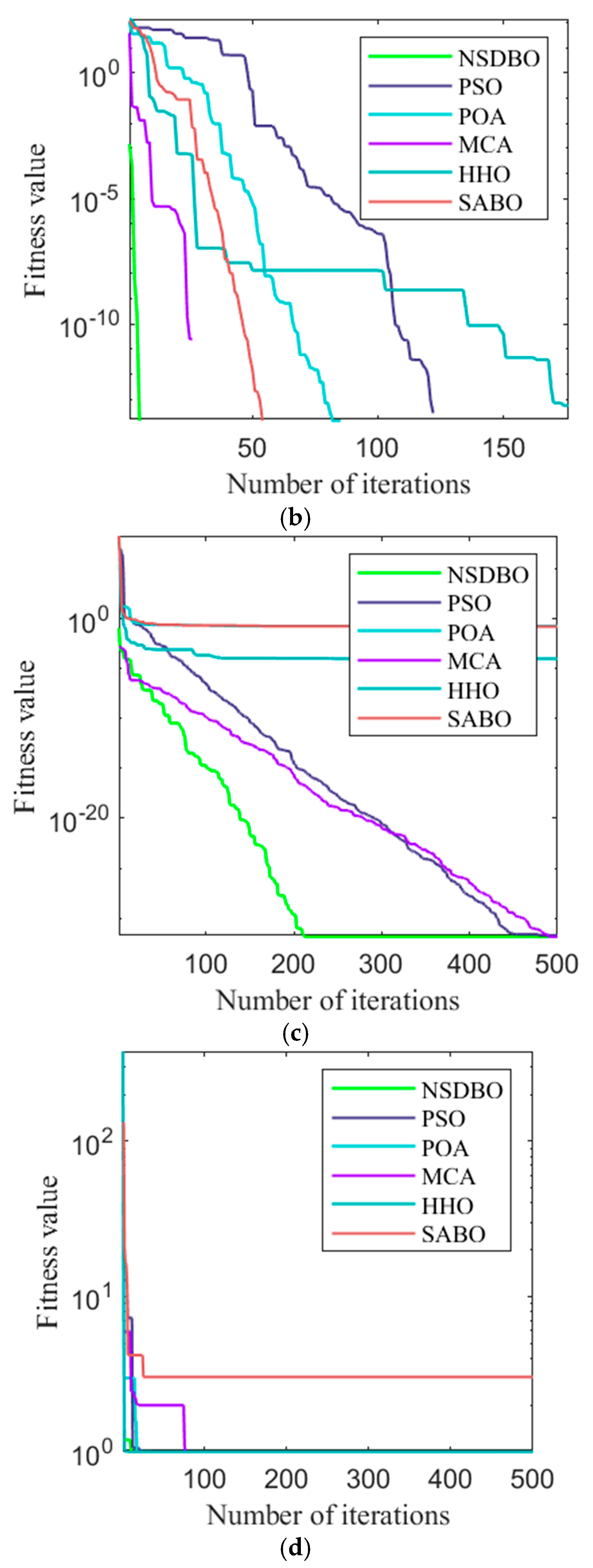
References
- Drosos, D.; Kyriakopoulos, G.L.; Arabatzis, G.; Tsotsolas, N. Evaluating Customer Satisfaction in Energy Markets Using a Multicriteria Method: The Case of Electricity Market in Greece. Sustainability 2020, 12, 3862. [Google Scholar] [CrossRef]
- Shafiullah, M.; Ahmed, S.D.; Al-Sulaiman, F.A. Grid Integration Challenges and Solution Strategies for Solar PV Systems: A Review. IEEE Access 2022, 10, 52233–52257. [Google Scholar] [CrossRef]
- Sinha, S.; Chandel, S.S. Review of recent trends in optimization techniques for solar photovoltaic-wind based hybrid energy systems. Renew. Sustain. Energy Rev. 2015, 50, 755–769. [Google Scholar] [CrossRef]
- Zhao, G.; Wan, C.X.; Zuo, W.Q.; Zhang, K.F.; Shu, X.Y. Research on Multiobjective Optimal Operation Strategy for Wind-Photovoltaic-Hydro Complementary Power System. Int. J. Photoenergy 2022, 2022, 5209208. [Google Scholar] [CrossRef]
- Ju, L.; Tan, Z.; Yuan, J.; Tan, Q.; Li, H.; Dong, F. A bi-level stochastic scheduling optimization model for a virtual power plant connected to a wind-photovoltaic-energy storage system considering the uncertainty and demand response. Appl. Energy 2016, 171, 184–199. [Google Scholar] [CrossRef]
- Liu, X.H.; Li, X.; Tian, J.Q.; Wang, Y.B.; Xiao, G.X.; Wang, P. Day-Ahead Economic Dispatch of Renewable Energy System considering Wind and Photovoltaic Predicted Output. Int. Trans. Electr. Energy Syst. 2022, 2022, 6082642. [Google Scholar] [CrossRef]
- Xu, M.; Cui, Y.; Wang, T.; Zhang, Y.Z.; Guo, Y.; Zhang, X.Y. Optimal Dispatch of Wind Power, Photovoltaic Power, Concentrating Solar Power, and Thermal Power in Case of Uncertain Output. Energies 2022, 15, 8215. [Google Scholar] [CrossRef]
- Min, H.L.; He, P.K.; Li, C.L.; Yang, L.B.; Xiao, F. The Temporal and Spatial Characteristics of Wind-Photovoltaic-Hydro Hybrid Power Output Based on a Cloud Model and Copula Function. Energies 2024, 17, 1024. [Google Scholar] [CrossRef]
- Chen, S.T.; Su, W.H.; Wu, B.Y. Two stage robust planning of park integrated energy system considering low carbon. Front. Ecol. Evol. 2023, 10, 1100089. [Google Scholar] [CrossRef]
- Zhang, Y.L.; Zhang, P.H.; Du, S.; Dong, H.L. Economic Optimal Scheduling of Integrated Energy System Considering Wind-Solar Uncertainty and Power to Gas and Carbon Capture and Storage. Energies 2024, 17, 2770. [Google Scholar] [CrossRef]
- Zhu, D.Y.; Cui, J.; Wang, S.J.; Wei, J.Z.; Li, C.R.; Zhang, X.M.; Li, Y.Z. An optimization strategy for intra-park integration trading considering energy storage and carbon emission constraints. J. Clean. Prod. 2024, 447, 141031. [Google Scholar] [CrossRef]
- Liu, L.; Qin, Z.J. Low-carbon planning for park-level integrated energy system considering optimal construction time sequence and hydrogen energy facility. Energy Rep. 2023, 9, 554–566. [Google Scholar] [CrossRef]
- Zhang, J.L.; Liu, Z.Y. Low carbon economic scheduling model for a park integrated energy system considering integrated demand response, ladder-type carbon trading and fine utilization of hydrogen. Energy 2024, 290, 130311. [Google Scholar] [CrossRef]
- Li, K.; Ying, Y.L.; Yu, X.Y.; Li, J.C. Optimal Scheduling of Electricity and Carbon in Multi-Park Integrated Energy Systems. Energies 2024, 17, 2119. [Google Scholar] [CrossRef]
- Chen, C.M.; Liu, C.; Ma, L.Y.; Chen, T.W.; Wei, Y.Q.; Qiu, W.Q.; Lin, Z.Z.; Li, Z.Y. Cooperative-game-based joint planning and cost allocation for multiple park-level integrated energy systems with shared energy storage*. J. Energy Storage 2023, 73, 108861. [Google Scholar] [CrossRef]
- Chen, H.Y.; Wang, S.C.; Yu, Y.X.; Guo, Y.; Jin, L.; Jia, X.Q.; Liu, K.C.; Zhang, X.H. Low-Carbon Operation Strategy of Park-Level Integrated Energy System with Firefly Algorithm. Appl. Sci. 2024, 14, 5433. [Google Scholar] [CrossRef]
- Wang, L.L.; Xian, R.C.; Jiao, P.H.; Liu, X.H.; Xing, Y.W.; Wang, W. Cooperative operation of industrial/commercial/residential integrated energy system with hydrogen energy based on Nash bargaining theory. Energy 2024, 288, 129868. [Google Scholar] [CrossRef]
- Xu, F.Q.; Li, X.P.; Jin, C.H. A multi-objective operation optimization model for the electro-thermal integrated energy systems considering power to gas and multi-type demand response. J. Renew. Sustain. Energy 2024, 16, 045301. [Google Scholar] [CrossRef]
- Ding, X.Y.; Yang, Z.P.; Zheng, X.B.; Zhang, H.; Sun, W. Effect of decision-making principle on P2G-CCS-CHP complementary energy system based on IGDT considering energy uncertainty. Int. J. Hydrogen Energy 2024, 81, 986–1002. [Google Scholar] [CrossRef]
- Vachhani, V.L.; Dabhi, V.K.; Prajapati, H.B. Improving NSGA-II for solving multi objective function optimization problems. In Proceedings of the 2016 International Conference on Computer Communication and Informatics, Coimbatore, India, 7–9 January 2016; pp. 1–6. [Google Scholar]
- Xue, J.; Shen, B. Dung beetle optimizer: A new meta-heuristic algorithm for global optimization. J. Supercomput. 2022, 79, 7305–7336. [Google Scholar] [CrossRef]
- Kennedy, J.; Eberhart, R. Particle swarm optimization. In Proceedings of the ICNN’95—International Conference on Neural Networks, Perth, WA, Australia, 27 November–1 December 1995; Volume 4, pp. 1942–1948. [Google Scholar] [CrossRef]
- Eltamaly, A.M.; Rabie, A.H. A Novel Musical Chairs Optimization Algorithm. Arab. J. Sci. Eng. 2023, 48, 10371–10403. [Google Scholar] [CrossRef]
- Trojovsky, P.; Dehghani, M. Pelican Optimization Algorithm: A Novel Nature-Inspired Algorithm for Engineering Applications. Sensors 2022, 22, 855. [Google Scholar] [CrossRef] [PubMed]
- Trojovsky, P.; Dehghani, M. Subtraction-Average-Based Optimizer: A New Swarm-Inspired Metaheuristic Algorithm for Solving Optimization Problems. Biomimetics 2023, 8, 149. [Google Scholar] [CrossRef] [PubMed]
- Heidari, A.A.; Mirjalili, S.; Faris, H.; Aljarah, I.; Mafarja, M.; Chen, H.L. Harris hawks optimization: Algorithm and applications. Future Gener. Comput. Syst.-Int. J. Escience 2019, 97, 849–872. [Google Scholar] [CrossRef]
- Li, Y.; Zou, Y.; Tan, Y.; Cao, Y.J.; Liu, X.D.; Shahidehpour, M.; Tian, S.M.; Bu, F.P. Optimal Stochastic Operation of Integrated Low-Carbon Electric Power, Natural Gas, and Heat Delivery System. IEEE Trans. Sustain. Energy 2018, 9, 273–283. [Google Scholar] [CrossRef]
- Lu, Q.; Guo, Q.S.; Zeng, W. Optimization scheduling of an integrated energy service system in community under the carbon trading mechanism: A model with reward-penalty and user satisfaction. J. Clean. Prod. 2021, 323, 129171. [Google Scholar] [CrossRef]
- Ba-swaimi, S.; Verayiah, R.; Ramachandaramurthy, V.K.; Alahmad, A.K. Long-term optimal planning of distributed generations and battery energy storage systems towards high integration of green energy considering uncertainty and demand response program. J. Energy Storage 2024, 100, 113562. [Google Scholar] [CrossRef]
- Zhang, X.Z.; Wang, Z.Y.; Lu, Z.Y. Multi-objective load dispatch for microgrid with electric vehicles using modified gravitational search and particle swarm optimization algorithm. Appl. Energy 2022, 306, 118018. [Google Scholar] [CrossRef]

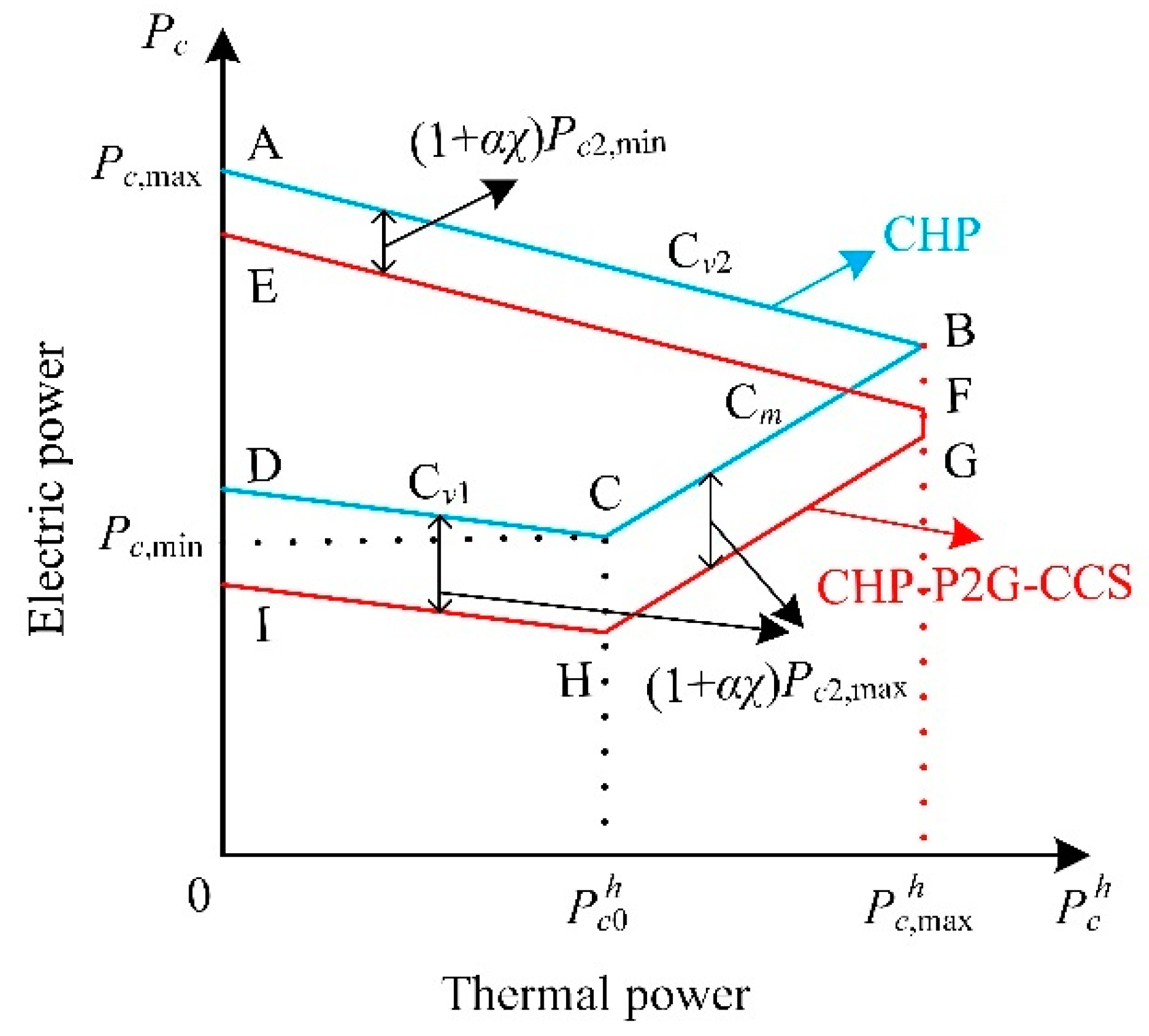
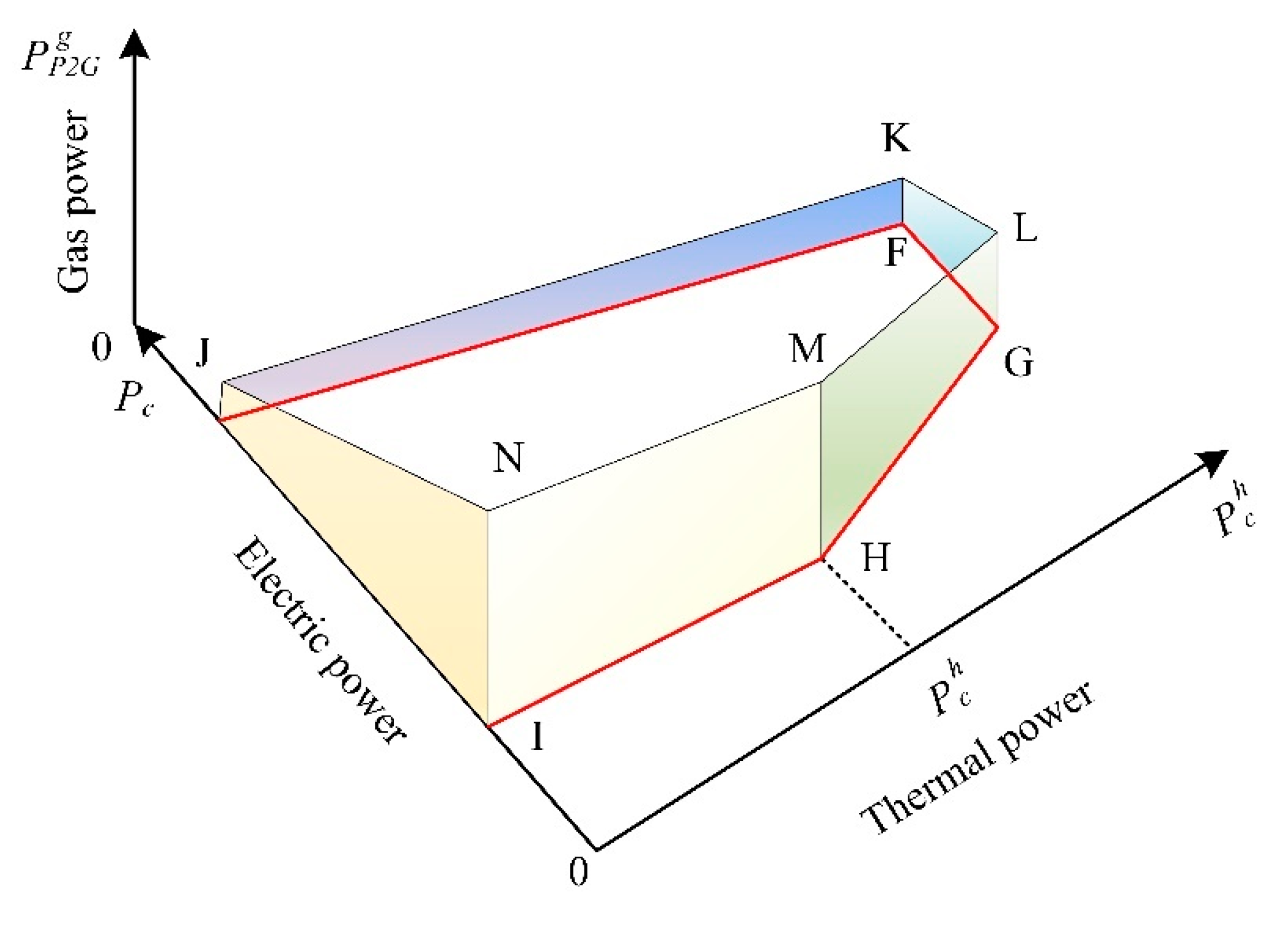

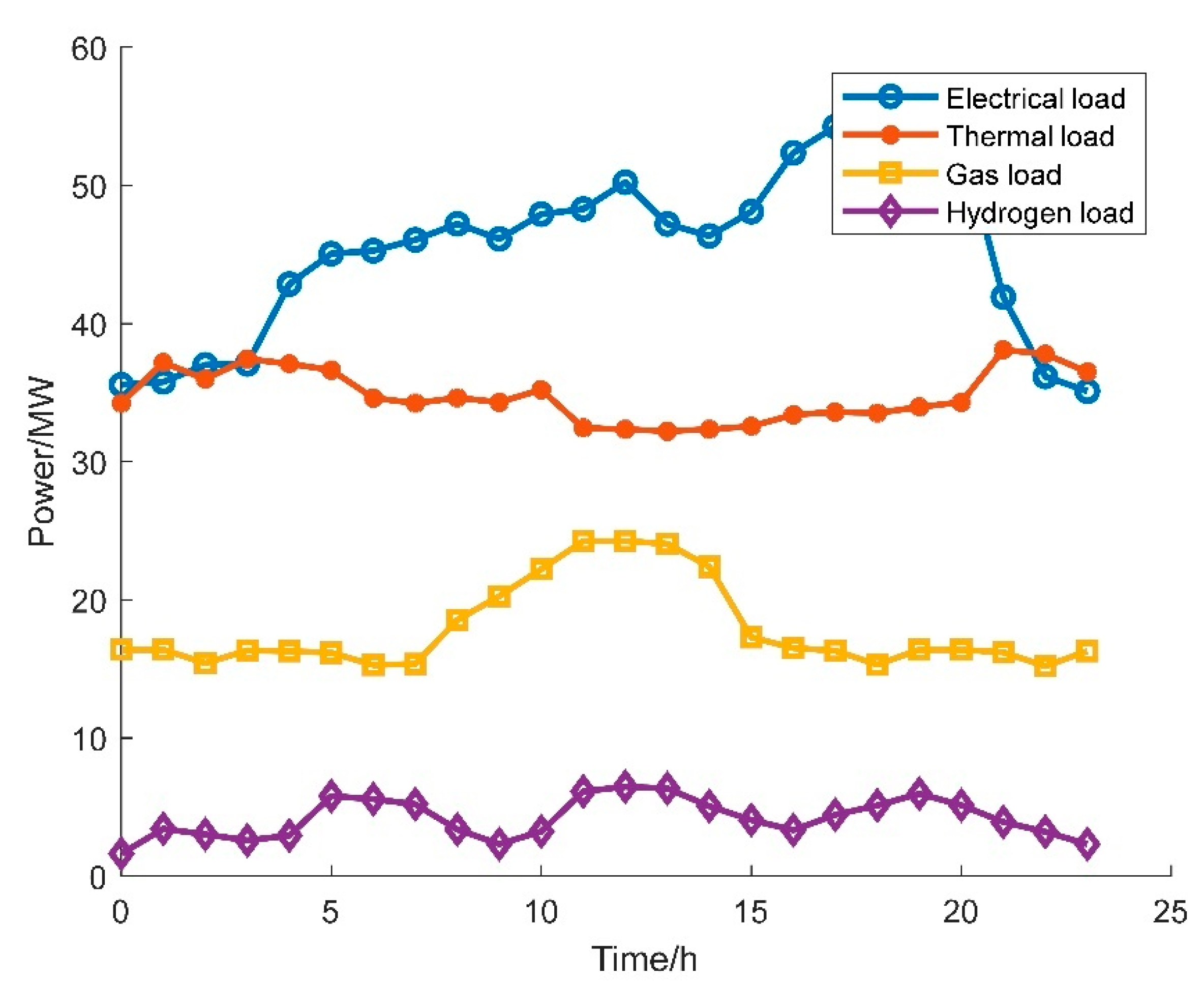
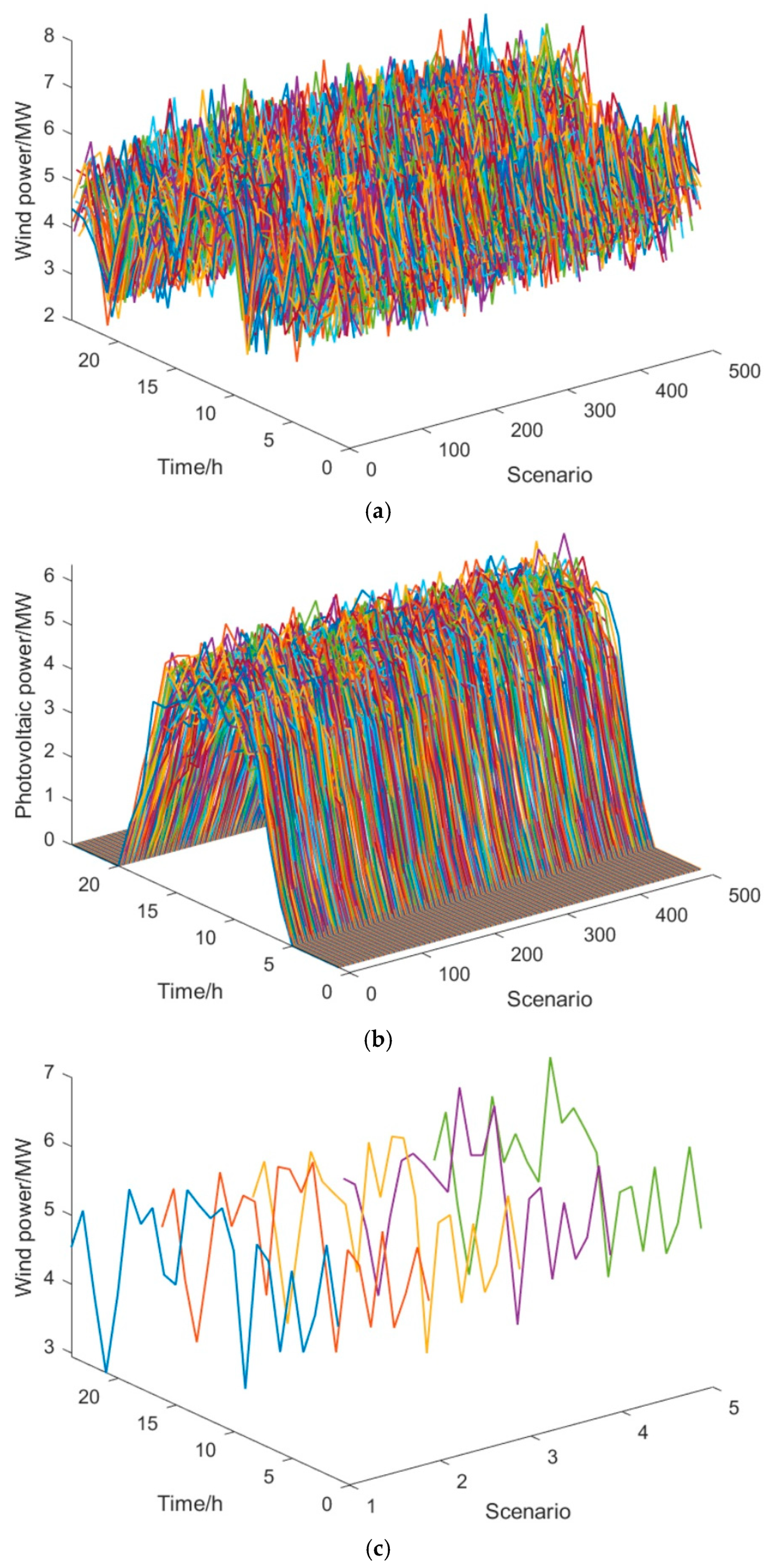



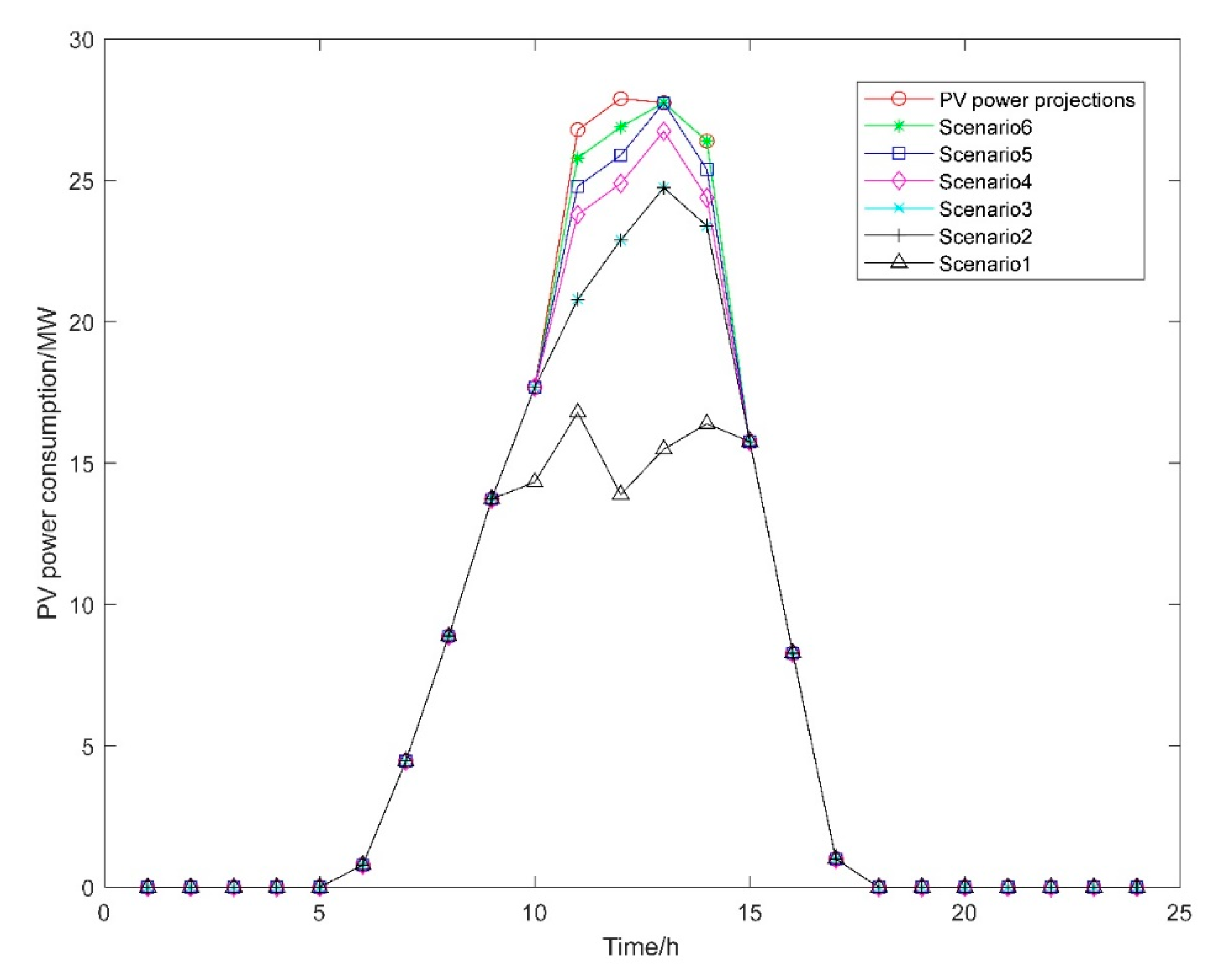
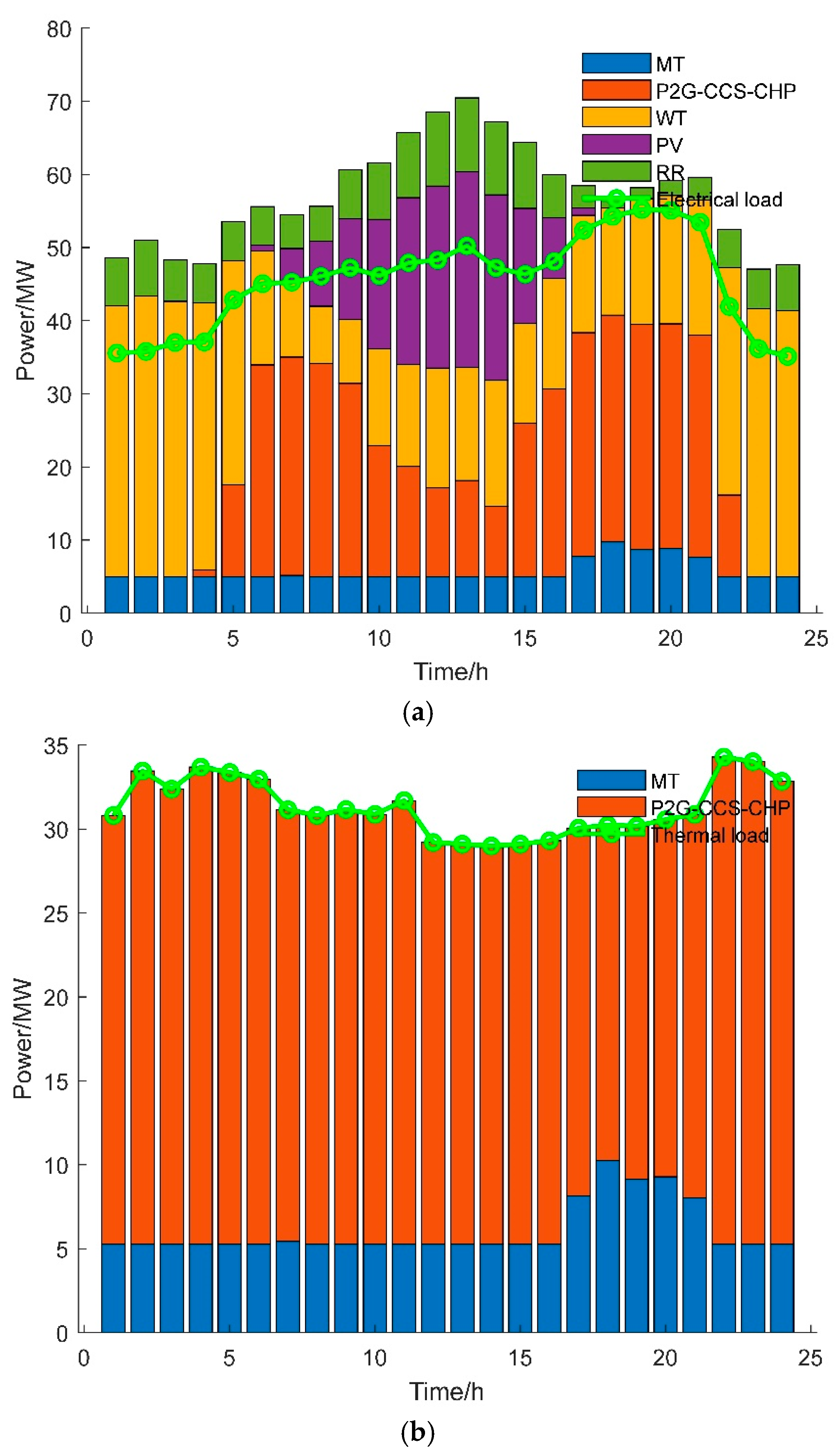
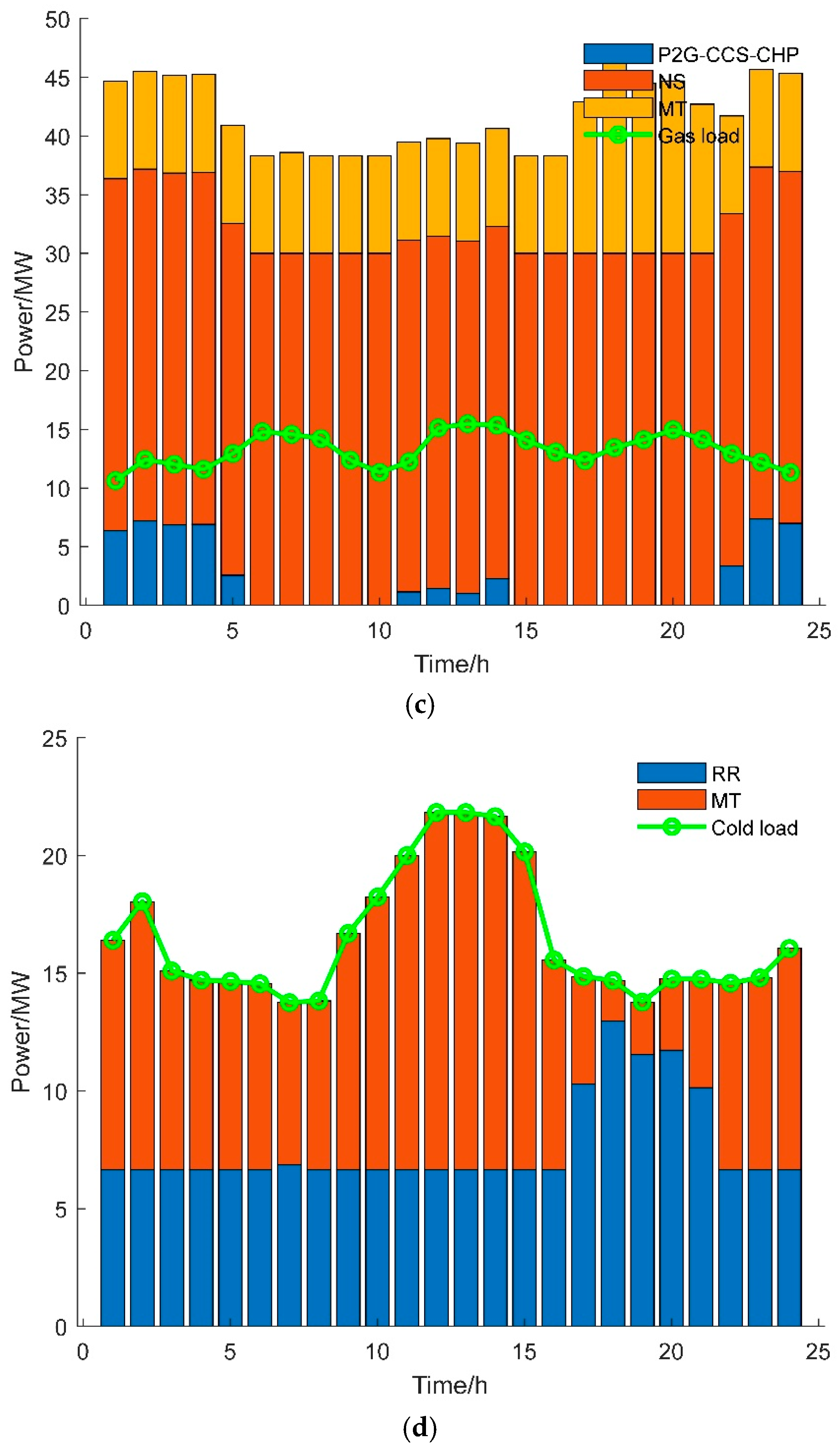


| Parameter | Numerical Value | Parameter | Numerical Value |
|---|---|---|---|
| 0.75 | −0.4 | ||
| 0.85 | 0.88 | ||
| (MW) | 100 | 6 | |
| (MW) | 0 | 6 | |
| (MW) | 30 | (MW) | 100(NS), 100(MT), 25(RR) |
| (MW) | 0 | (MW) | 0(NS), 0(MT), 0(RR) |
| (MW) | 50 | (MW) | 10(CHP), 10(MT), 2.5(RR) |
| −0.3 | (MW) | 0(CHP), 0(MT), 0(RR) | |
| 1 | 0.285(G2P,MT), 0.38(G2H,MT), 0.285(G2C,MT), 0.97(E2C,RR) | ||
| 0.75 | −0.4 | ||
| 0.85 | 0.88 | ||
| (MW) | 100 | 6 | |
| (MW) | 0 | 6 |
| Scene | Probit |
|---|---|
| 1 | 0.226 |
| 2 | 0.228 |
| 3 | 0.234 |
| 4 | 0.13 |
| 5 | 0.182 |
| Operating Result | Methods 1 | Methods 2 | Methods 3 | Methods 4 |
|---|---|---|---|---|
| Operating costs/USD | 11,633.65 | 33,338.64 | 19,207.90 | 22,797.95 |
| Carbon emissions/kg | 56,177.74 | 1238.71 | 11,438.22 | 9106.63 |
| Environmental protection costs/USD | 17,389.77 | 1486.79 | 3914.68 | 3426.38 |
| Total cost/USD | 29,023.41 | 34,825.43 | 23,122.59 | 26,224.33 |
| Scenario | Operating Costs/USD | Environmental Protection Costs/USD | Total Cost/USD | Carbon Emissions/kg | WT Utilization Rate/% | PV Utilization Rate/% |
|---|---|---|---|---|---|---|
| Scenario 1 | 26,637.65 | 10,010.43 | 36,648.07 | 51177.74 | 53.44 | 65.27 |
| Scenario 2 | 24,158.65 | 9122.30 | 33,280.95 | 47018.92 | 58.82 | 69.36 |
| Scenario 3 | 22,005.03 | 7085.39 | 29,090.43 | 30645.65 | 60.62 | 70.10 |
| Scenario 4 | 20,636.10 | 5445.35 | 26,081.45 | 19780.99 | 71.74 | 72.01 |
| Scenario 5 | 19,805.39 | 4197.62 | 24,003.01 | 13589.00 | 77.90 | 80.21 |
| Scenario 6 | 19,207.90 | 3914.68 | 23,122.59 | 11438.22 | 82.30 | 85.12 |
Disclaimer/Publisher’s Note: The statements, opinions and data contained in all publications are solely those of the individual author(s) and contributor(s) and not of MDPI and/or the editor(s). MDPI and/or the editor(s) disclaim responsibility for any injury to people or property resulting from any ideas, methods, instructions or products referred to in the content. |
© 2025 by the authors. Licensee MDPI, Basel, Switzerland. This article is an open access article distributed under the terms and conditions of the Creative Commons Attribution (CC BY) license (https://creativecommons.org/licenses/by/4.0/).
Share and Cite
Zhang, Z.; Li, X.; Zhang, L.; Zhao, H.; Wang, Z.; Li, W.; Wang, B. Optimized Dispatch of Integrated Energy Systems in Parks Considering P2G-CCS-CHP Synergy Under Renewable Energy Uncertainty. Processes 2025, 13, 680. https://doi.org/10.3390/pr13030680
Zhang Z, Li X, Zhang L, Zhao H, Wang Z, Li W, Wang B. Optimized Dispatch of Integrated Energy Systems in Parks Considering P2G-CCS-CHP Synergy Under Renewable Energy Uncertainty. Processes. 2025; 13(3):680. https://doi.org/10.3390/pr13030680
Chicago/Turabian StyleZhang, Zhiyuan, Xiqin Li, Lu Zhang, Hu Zhao, Ziren Wang, Wei Li, and Baosong Wang. 2025. "Optimized Dispatch of Integrated Energy Systems in Parks Considering P2G-CCS-CHP Synergy Under Renewable Energy Uncertainty" Processes 13, no. 3: 680. https://doi.org/10.3390/pr13030680
APA StyleZhang, Z., Li, X., Zhang, L., Zhao, H., Wang, Z., Li, W., & Wang, B. (2025). Optimized Dispatch of Integrated Energy Systems in Parks Considering P2G-CCS-CHP Synergy Under Renewable Energy Uncertainty. Processes, 13(3), 680. https://doi.org/10.3390/pr13030680






